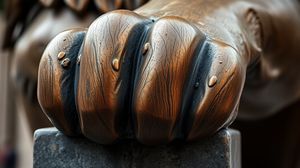
The statue of Charles I in Trafalgar Square, London, is a remarkable piece of historical artistry. It stands on a site known today as King Charles I Island, where Charing Cross, the historical center of London, was located. The statue, crafted by Hubert Le Sueur, dates back to 1633 and is among the oldest bronze statues in the city, preserving the regal image of the monarch who was famously executed in 1649.
What makes this statue particularly intriguing is that it survived both the English Civil War and the subsequent Interregnum. During Oliver Cromwell's rule, many royal symbols were destroyed or damaged, but this statue was hidden away and ultimately kept intact. It was reinstalled in 1675 following the restoration of the monarchy.
An intriguing aspect of the statue's history involves its hand. A popular anecdote suggests that the statue's hand was replaced during its restoration. According to this tale, executed by a sleight of hand, the original sculpture lost its hand, which was surreptitiously reattached when it was re-erected. However, evidence for this story remains cloudy, adding a layer of mystery to its history.
Positioned at a significant vantage point, the statue gazes down Whitehall towards the Banqueting House, where Charles I was executed. This alignment is seen by many as a poignant reminder of his dramatic and turbulent reign.
The equestrian statue is also notable for its attention to detail, as Charles I is depicted in full armor and sitting astride a magnificently detailed horse. The craftsmanship of both the King and the steed reflects the artistry of the early 17th century, capturing not only a likeness but also the spirit of monarchical power.

Making the Most of Your Visit:
If you're visiting the statue, try to align your visit with a quieter time, perhaps early in the morning or late in the evening. Trafalgar Square can get pretty busy, and you'll have more space to appreciate the historical significance and unique details of the statue without the crowds.
Take a moment to look closely at the detailed armor and the horse—it's a testament to the artistry of the 17th century. Notice the attention to detail that brings historic figures and their grandeur to life through metalwork.
The statue isn't fenced off, so you can walk right up to it. Standing right beneath its shadow can give you a different perspective, especially when you gaze down the same line of sight to Whitehall where Charles I was executed.
Consider standing back and observing how the statue fits into the modern landscape of Trafalgar Square. The blending of history with modern city life at this location offers a fascinating juxtaposition and a reminder of the passage of time.
Look out for any signs or plaques that give additional context. The history around Charles I and this statue is intriguing, involving secretive rescues and royal symbolism—it adds another layer to your visit.

Visiting Times & Costs:
The "Charles I Statue" in Trafalgar Square is accessible to the public at all times, as it is situated in an open public space. There is no entrance fee or charge to view the statue, making it a cost-free attraction for visitors to enjoy.
There are no specific accessibility barriers to viewing the statue, as Trafalgar Square generally accommodates visitors with differing mobility needs. However, like any open area, it's important to navigate with care, particularly when the square is crowded.
The statue is located on a traffic island at the southern end of Trafalgar Square, which requires crossing roads to access, so visitors should be mindful of traffic and use designated crossings.
It's worth noting that as an outdoor monument, visiting is subject to weather conditions, and the experience may vary depending on the time of day and the level of pedestrian traffic in the area.

Address & Map:

Nearby:























